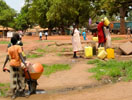
BOR, Southern Sudan — We’ve spent a lot of time reporting on the potential game-changing political milestones coming up in Sudan in the next year. But now consider this: 5 of the 10 states in South Sudan have already entered a “pre-famine” stage, according to a top U.N. official.
On a visit to Jonglei state, one of the areas hardest hit by violent inter-ethnic clashes this year, UNICEF’s Hilde Johnson warned that “the crisis is going to hit very, very hard.” As as a former lead negotiator on Sudan’s 2005 Comprehensive Peace Agreement, Hilde is a seasoned Sudan authority who has seen some of Sudan’s low points in recent years; the international community would do well to heed her warning.
Delayed rains, pervasive insecurity and political tensions, and enduring food insecurity (caused by a climate that makes growing food challenging) are just some of the factors contributing to what Lise Grande, the U.N.’s head of humanitarian coordination in South Sudan, called a “perfect humanitarian storm” back in August.
There is limited humanitarian data on southern Sudan. Almost five years after the Comprehensive Peace Agreement was signed, the semi-autonomous region of southern Sudan is slowly recovering from more than four decades of conflict. Statistics on the South are becoming more prevalent as more studies and analysis are conducted, but since the region is considered a part of Sudan, the South’s alarming humanitarian and health statistics remain under wraps; when combined with the North’s higher rates of literacy and better infrastructure, Sudan does not fall to the bottom of development and health indices.
A U.N. official provided me with a document aptly titled “Scary Statistics” on Sudan, much of which was gathered from the Sudan Household Survey from 2006. Here is a snapshot of just how “scary” these stats are:
- More than 90 percent of the population in southern Sudan currently live on less than 1 U.S. dollar per day.
- One out of seven women who become pregnant in southern Sudan will die from pregnancy-related causes.
- Although the under-5 mortality rate has decreased, one out of every 7 children will die before their fifth birthday (135 per 1000 live births).
- For every 1,000 primary school students there is only one teacher.
- 85 percent of adults in southern Sudan do not know how to read or write.
The extremely fragile humanitarian situation in the South means that much of the southern population hangs by a thread. In these conditions, a violent militia attack on a village can be enough to push people over the edge. The displaced often have no reserves and little support in the struggle to feed their children or create any kind of business or opportunity for themselves. The violence that has rocked the South this year cannot be explained by one single factor, but one thing is for sure: its impact is felt acutely at the local level, by people who have already suffered a great deal and stand to lose more in the coming months, as the elections approach and the potential for violence and further insecurity increases.
Rather than buy in to the rhetoric that southern Sudan will be “ungovernable” or “not viable” if its people choose independence in the 2011 referendum, governments and donors should be coordinating efforts to prevent and mitigate further violence during the electoral process so that southern Sudan is not pushed over the edge before we even get to January 2011.
Photo: Women collect water at a central tap in Rumbek. (Enough/Maggie Fick)

